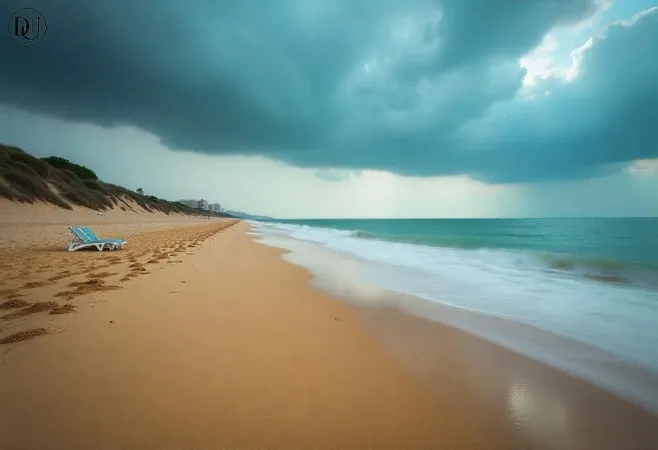Who'd have thought torrential rain and hailstones would be the biggest worry for tourists hitting the Balearics or Costa del Sol this summer? It just seems totally counter-intuitive, doesn't it? Like, you picture Spain in July or August, and it's all blazing sun, clear skies, maybe a little heat haze over the Med. But that's not really the full picture anymore, apparently.
Turns out, Spain’s iconic summer season is being seriously messed with by some intense storms, and it’s throwing a massive wrench into people’s carefully planned holidays. We're talking weather alerts, major disruptions, and honestly, a lot of very soggy tourists. I mean, you save up all year, plan this perfect escape, and then boom—you're dealing with what sounds like a mini-monsoon. It's wild.
🌊 Unexpected Summer Deluges
People mostly associate severe weather in Spain with the autumn, maybe a DANA event bringing heavy downpours then. But these summer storms are something else. They’re hitting the spots where everyone wants to be: the Balearic Islands, like Mallorca and Ibiza, and then the whole Costa del Sol stretch, from Marbella down to Malaga. It’s not just a passing shower either. We’re talking proper, disruptive rain, strong winds, and even hail.
I remember visiting Spain once in summer and it was just relentless sun. You know, you kinda take it for granted. So to hear about these heavy summer storms, it really makes you pause. It impacts everything, doesn't it? From just lounging by the pool to trying to get around and see some sights. It’s a complete game-changer for a holiday.
⚠️ Red & Orange Alerts Everywhere
The Spanish State Meteorological Agency, AEMET, has been putting out these pretty serious alerts. We're seeing red and orange warnings for parts of the Balearics and Costa del Sol, which basically means 'be very careful' or 'expect extreme danger.' Red alerts are obviously the most severe, indicating a high risk to people and property. This isn't just about a bit of rain for a few hours, it's about significant weather events that demand attention. Like, you really need to be aware if you’re planning to head out there or if you’re already on the ground.
It must be terrifying for tourists, honestly, especially if they're not used to that kind of weather. You see the pictures of the aftermath, and it’s pretty shocking. It just goes to show how quickly things can change, even in places you expect to be perpetually sunny.
🚗 Underwater Cars, Shattered Plans
You’ve probably seen the images floating around online, or maybe on news sites. Cars submerged, literally underwater on what should be perfectly dry streets. Hail the size of golf balls, smashing things. I saw a bit about how some areas got hit so hard that vehicles were just floating, and roads became rivers. That's not just a disruption; that's property damage, safety hazards. People's rental cars, basically new purchases for some, getting trashed. It’s a nightmare. The Daily Record and The Sun covered some of those particularly gnarly incidents, showing just how bad it got in places like Calvia, Mallorca. One minute you're driving to the beach, the next your car's an impromptu submarine. You know, it really makes you think about travel insurance, right?
![]()
✈️ Travel Chaos & What It Means
Naturally, this severe weather isn't just about wet clothes and dented cars. It's causing real havoc for travel. Flights getting delayed or cancelled, ferries unable to sail—all the usual suspects when Mother Nature decides to throw a tantrum. I’m not 100% sure on the exact numbers for cancellations, but I can imagine it's pretty substantial. Airports in places like Palma de Mallorca have seen major disruptions. Basically, if you were planning to arrive or leave, your schedule probably got completely messed up. It’s a cascading effect, basically; one delayed flight then impacts dozens of others. And it's not just inbound/outbound travel; local transport, like buses and taxis, gets hit too. Getting around a resort area becomes almost impossible when the roads are flooded. It’s just a massive headache for everyone involved, especially for tour operators trying to keep things smooth.
🤷♀️ So, What Should Tourists Do?
If you're heading to Spain or you’re already there, checking the weather forecast isn't just a suggestion, it's pretty much mandatory. AEMET’s website is your best friend here. They'll have the latest alerts and predictions. You've gotta stay informed. Also, having good travel insurance that covers weather-related disruptions is suddenly way more important than it used to be for a summer trip to Spain. Most policies do cover things like flight delays due to weather, but it's always worth double-checking the fine print for things like accommodation changes or activity cancellations. And just, you know, be flexible. Holiday plans might need to pivot. Maybe that beach day turns into a museum visit—if you can get there safely, of course. It’s about adapting to the unpredictable, which feels like the new normal these days.
🌍 A Shifting Climate Reality?
You can’t help but wonder if these kinds of intense, unexpected summer storms are part of a larger pattern. Like, is this just weird weather, or are we seeing the impacts of climate change making things more extreme, even in places we once thought were pretty stable, weather-wise? I mean, the Mediterranean region is already super vulnerable to climate shifts, and these kinds of events, where you get crazy intense downpours in what should be bone-dry summer months, they do make you scratch your head a bit. Could be wrong, but it just feels like the weather everywhere is getting… more dramatic. It adds another layer of uncertainty to travel, doesn't it? Not just when to go, but whether the weather will actually cooperate. It just seems like something that’s going to keep cropping up. And travelers, along with the tourism industry, are just going to have to figure out how to deal with it.










